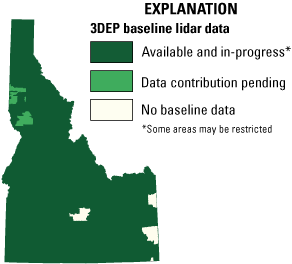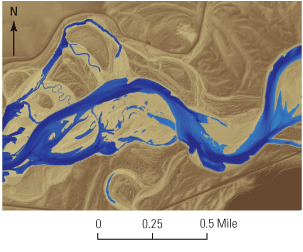The 3D Elevation Program—Supporting Idaho’s Economy
Links
- Document: Report (1.45 MB pdf) , HTML , XML
- Download citation as: RIS | Dublin Core
Introduction
Due to Idaho’s inland location approximately 350 miles from the Pacific Ocean and its 80 recognized mountain ranges, the State’s climate varies widely, with maritime influence in the northern and western parts of Idaho and continental influence on the eastern side. The weather in the abundant mountains is unpredictable and often associated with natural hazards such as severe thunder and lightning storms leading to flooding, landslides, and wildfires. Issues important to Idaho’s economy include river, stream, and forest resource management, and infrastructure and construction management. Idaho participated in the U.S. Geological Survey (USGS) 3D Elevation Program (3DEP) in 2016, the State’s first 3DEP project. The success of this project led to development of the Idaho Statewide Lidar Plan (Elevation Technical Working Group and Idaho Lidar Consortium, 2018). Critical applications that meet the State’s management needs depend on light detection and ranging (lidar) data that provide a highly detailed three-dimensional (3D) model of the Earth’s surface and aboveground features.
The 3D Elevation Program (see sidebar) is managed by the U.S. Geological Survey in partnership with Federal, State, Tribal, U.S. territorial, and local agencies to acquire consistent lidar coverage at quality level 2 or better (table 1) to meet the many needs of the Nation and Idaho. The status of available and in-progress 3DEP baseline lidar data in Idaho is shown in figure 1. 3DEP baseline lidar data include quality level 2 or better, 1-meter or better digital elevation models, and lidar point clouds, and must meet the Lidar Base Specification version 1.2 (https://www.usgs.gov/3dep/lidarspec) or newer requirements. The National Enhanced Elevation Assessment (Dewberry, 2012) identified user requirements and conservatively estimated availability of lidar data would result in at least $6.12 million in new benefits annually to the State. The top eight Idaho business uses for 3D elevation data, which are based on the estimated annual conservative benefits of 3DEP, are shown in table 2.

Map of Idaho showing status of 3D Elevation Program (3DEP) baseline lidar data as of September 2023. Visit https://usgs.gov/NationalMap/LidarExplorer to find and download currently available data.
Table 1.
Data quality levels, pulse spacing, and pulse density. Quality level 2 or better lidar data meet 3DEP requirements.[Specifications for quality level 0 (QL0) are from Heidemann (2012, p. 3 and table 1); for quality levels 1 and 2, specifications are from Sugarbaker and others (2014, table 1). In the quality level column, QL0 represents the highest level of quality. RMSEz, root mean square error in the elevation (z) dimension; cm, centimeter; m, meter; pls/m2, first return pulses per square meter; ≤, less than or equal to; ≥, greater than or equal to]
Status of 3DEP in Idaho
3DEP quality level 1 lidar collections are being planned for parts of central and southern Idaho. These plans would most likely take place during the 2023 collection cycle. Subsequent collections would take place along the Idaho-Montana border in parts of central and northern Idaho during the 2024 cycle.
River and Stream Resource Management
The river and stream resource management business use is associated with ensuring the Nation’s rivers and streams sustain economic, recreational, and subsistence activities and their other beneficial functions. Lidar data improve the results of related activities such as hydrologic and hydraulic modeling of rivers and streams, mapping of flood plains, ecosystem management, establishment of accurate stream buffers, and enabling stormwater quality management (fig. 2). In addition, lidar data enable identification of stream restoration opportunities, provide critical information on stream health, and help cities and counties accurately assess developer plans for controlling stormwater runoff in new residential and commercial developments. Overall, lidar data help governments to be more efficient and effective in managing the State’s rivers and streams while providing added cost savings to the public.
Flood Risk Management
The Idaho Department of Water Resources (IDWR) utilizes lidar to determine drain elevations for groundwater modeling and for both flood hazard mapping and flood investigations. IDWR’s Water Resource Board has been using lidar for the assessment of water infrastructure projects. Ada County Emergency Management (ACEM) supports the acquisition of lidar data as part of its Multi-Hazard Mitigation Plan for flooding, wildfires, and landslide risks. As part of this effort, ACEM has utilized bathymetric lidar for flood modeling the Boise River, creating maps used for public outreach, and emergency response planning.
Wildfire Management, Planning, and Response
The Idaho Department of Lands (IDL) manages Idaho’s State Trust Lands and provides regulatory oversight of forestry practices and some regulation of mining practices on State lands. The IDL also administers forestry programs and provides fire protection on State lands. According to Geoff Klein, IDL program manager, written commun., May 5, 2019, “IDL has been collecting and utilizing lidar across state endowment lands since 2015 to assist state foresters in decision making. IDL utilizes lidar for forest road engineering design to access areas for timber harvesting. They also use lidar point clouds for developing forest canopy height models and to assist with models of stand volume and other inventory metrics.”
Geologic Resource Assessment and Hazard Mitigation
Geologic mapping, including the assessment of mineral deposits and geologic hazards, can be performed more efficiently and accurately using lidar data and provides significant cost savings by reducing the need for in-field investigations. The geologic maps produced by the Idaho Geological Survey provide a base for further geologic exploration and depict faults, folds, landslides, and cross sections of geologic units.
The value of Idaho mineral extraction was $185 million in 2019 (U.S. Geological Survey, 2020). Gemstone-quality garnet, jasper, and opal are found in Idaho, and contribute to the mineral extraction economy.
“Terrestrial lidar has been collected by Ada County Emergency Management across the Boise foothills in Ada County to incorporate into wildfire hazard maps that are used in landslide risk assessments.”
—Paul Marusich, Emergency Planner for Ada County, written commun., May 5, 2019.

Image of the Kootenai River near Bonners Ferry, Idaho, derived from lidar point cloud and bathymetry data. Dark blue is the deepest depth below the water surface; light blue is the shallowest. The lightest tan color represents the lowest terrestrial elevation, with dark brown representing the highest elevation. Bathymetry and terrestrial elevations can be derived from these data. The lidar data are an integral part of a U.S. Geological Survey environmental restoration and flood modeling project. Image courtesy of NV5 Geospatial, Meridian, Idaho.
Table 2.
Conservative benefits estimates for the top eight Idaho business uses of the proposed 3DEP data identified in the National Enhanced Elevation Assessment (Dewberry, 2012).3D Elevation Program (3DEP)
The 3D Elevation Program is managed by the U.S. Geological Survey (USGS) on behalf of the community of Federal, State, Tribal, local, and other partners and users of elevation data. In response to growing needs for high-quality elevation data, the goal of 3DEP is to complete acquisition of nationwide light detection and ranging (lidar) data (interferometric synthetic aperture radar [IfSAR] data in Alaska) to provide the first-ever national baseline of consistent, high-resolution topographic elevation data—both bare-earth digital elevation models and 3D point clouds.
Benefits
-
• Economies of scale by acquiring data for larger areas.
-
• Predictable and flexible Federal investments that reduce costs and allow better planning.
-
• Consistent national coverage that provides data for applications that span project, jurisdictional, and watershed boundaries.
-
• Simplified data acquisition that provides contracts, project management, quality assurance, and published data specifications.
-
• National benefits of $690 million per year conservatively, with the potential to generate $13 billion per year in additional benefits through applications that span the economy (Dewberry, 2012).
High-Quality Data and Products
3DEP lidar data provide coverage with a minimum of two points per square meter and a vertical error not to exceed 10 centimeters, measured as root mean square error in the elevation (z) dimension (RMSEz) (see table 1). 3DEP baseline lidar data products include all data points collected (point clouds) and bare-earth digital elevation models with a 1-meter or better resolution. The USGS integrates the elevation data into The National Map. Data are available free of charge and without use restrictions. To download 3DEP products visit https://apps.nationalmap.gov/downloader/.
Ways to Participate
Participation in 3DEP is open to Federal, State, Tribal, U.S. territorial, and local government partners, as well as private sector partners, and offers the option to acquire higher quality data. Partners may contribute funds toward projects managed by the USGS, or they may receive cooperative funds to manage their own projects. An annual Broad Agency Announcement is the mechanism used to establish partner agreements. Organizations and the private sector may contribute existing data that meet 3DEP requirements. For more information refer to the 3DEP website at https://usgs.gov/3DEP/collaborate/.
References Cited
Dewberry, 2012, Final report of the National Enhanced Elevation Assessment (revised March 29, 2012): Fairfax, Va., Dewberry, 84 p. plus appendixes, accessed June 15, 2022, at https://www.dewberry.com/services/geospatial/national-enhanced-elevation-assessment.
Elevation Technical Working Group and Idaho Lidar Consortium, 2018, Idaho Statewide Lidar Plan, version 1.1: Idaho Geospatial Council, July 19, 2018, accessed June 15, 2022, at https://ita.idaho.gov/wp-content/uploads/sites/3/2018/10/Idaho_Statewide_Lidar_Plan_Final_2018.pdf.
Heidemann, H.K., 2012, Lidar base specification (ver. 1.2, November 2014): U.S. Geological Survey Techniques and Methods, book 11, chap. B4, 67 p. with appendixes, accessed August 3, 2022, at https://doi.org/10.3133/tm11B4.
Sugarbaker, L.J., Constance, E.W., Heidemann, H.K., Jason, A.L., Lukas, V., Saghy, D.L.,and Stoker, J.M., 2014, The 3D Elevation Program initiative—A call for action: U.S. Geological Survey Circular 1399, 35 p., accessed June 15, 2022, at https://doi.org/10.3133/cir1399.
U.S. Geological Survey, 2020, Mineral commodity summaries 2020: U.S. Geological Survey, 200 p., accessed April 17, 2023, at https://doi.org/10.3133/mcs2020.
Any use of trade, firm, or product names in this publication is for descriptive purposes only and does not imply endorsement by the U.S. Government.
For Further Information:
Director, National Geospatial Program
U.S. Geological Survey, MS 511
12201 Sunrise Valley Drive
Reston, VA 20192
Email: 3DEP@usgs.gov
USGS National Map Liaison: Tom Carlson
Email: tcarlson@usgs.gov
Disclaimers
Any use of trade, firm, or product names is for descriptive purposes only and does not imply endorsement by the U.S. Government.
Although this information product, for the most part, is in the public domain, it also may contain copyrighted materials as noted in the text. Permission to reproduce copyrighted items must be secured from the copyright owner.
Suggested Citation
Carlson, T., 2023, The 3D Elevation Program—Supporting Idaho’s economy: U.S. Geological Survey Fact Sheet 2023–3035, 2 p., https://doi.org/10.3133/fs20233035.
ISSN: 2327-6932 (online)
Study Area
| Publication type | Report |
|---|---|
| Publication Subtype | USGS Numbered Series |
| Title | The 3D Elevation Program—Supporting Idaho’s economy |
| Series title | Fact Sheet |
| Series number | 2023-3035 |
| DOI | 10.3133/fs20233035 |
| Publication Date | October 10, 2023 |
| Year Published | 2023 |
| Language | English |
| Publisher | U.S. Geological Survey |
| Publisher location | Reston, VA |
| Contributing office(s) | National Geospatial Program |
| Description | 2 p. |
| Country | United States |
| State | Idaho |
| Online Only (Y/N) | Y |
| Additional Online Files (Y/N) | N |


